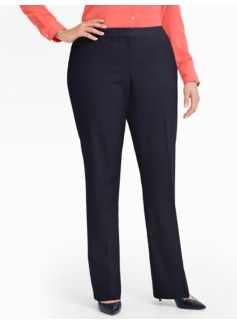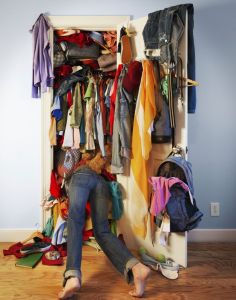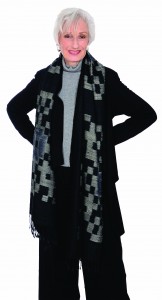The Secrets of Dressing to Suit Your Style
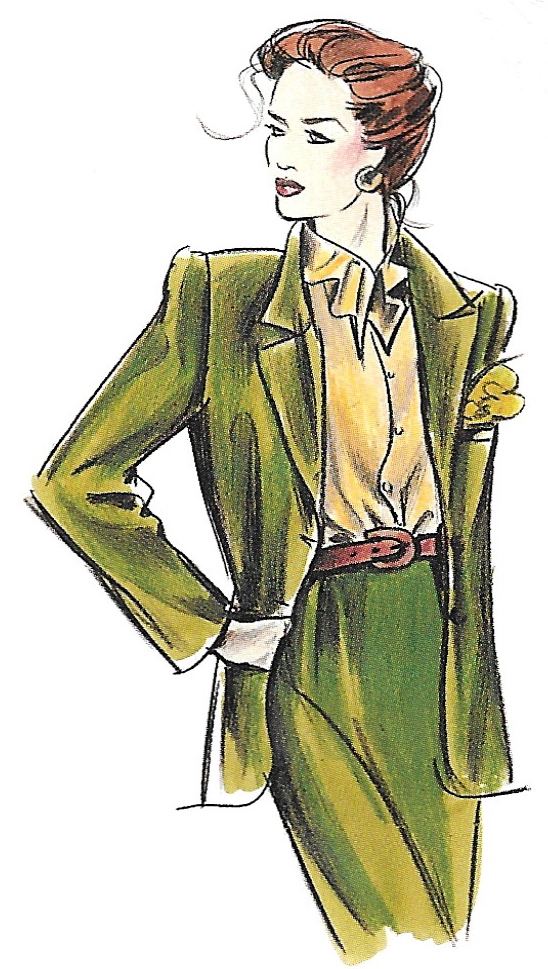
Tailored Classic Style
Looking great is less about what’s “in” and what’s “out” and more about what works best for YOU. Whether you are reaching for the next level in your career or embracing a lifestyle change, developing a style that is in sync with who you are says to everyone who sees you “I know who I am”.
Style is an art and a science and it is the sum of who we are. It’s not about beauty; it’s about being inherently individual, distinctive, and many times original. There’s a saying that you either have it or you don’t, but I believe having style in how you dress can be learned and developed.
The skill of dressing your best is developed through knowledge and use of your most flattering colors – your color style – plus an understanding of your body style and how to dress it in the most flattering way. But it’s your personal style — your spirit, your character — that pulls your look together. If you ignore your personal style and only buy clothes because they are the latest “must haves” or trends of the season, you lose your identity and risk wasting your clothing dollars.
Personal Style
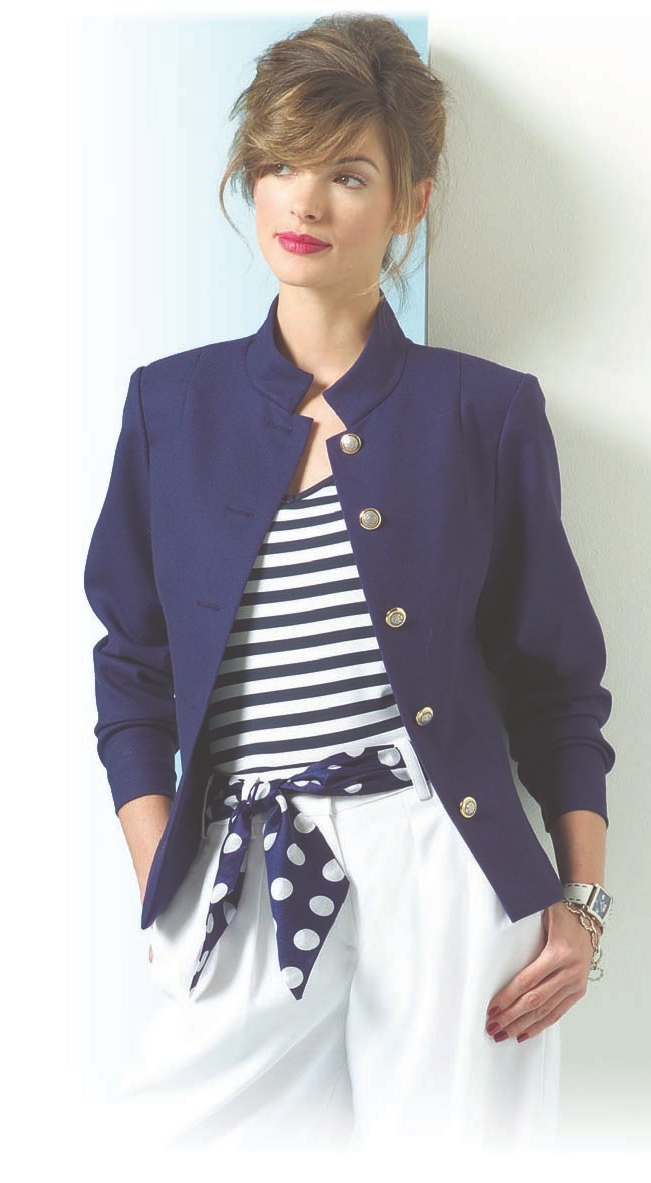
Sportive & Creative
How often have you tried something on and said, “It’s just not me.” Why not? It was not reflecting your “personal style”.
It’s important to understand and respect what is most comfortable for you to wear, what feels like you. Then, to present your best self, relate it to the fashion style that’s appropriate for your lifestyle.
Here are the five most often referenced fashion personality types and characteristics of each:
- Tailored Classic – you like an understated, refined look with simple lines and balanced proportions.
- Sportive – you like comfortable clothing – sportswear that’s suitable for active sports and casual lifestyles.
- Romantic – you like soft, unstructured, flowing clothing and very feminine touches.
- Dramatic – you like bold lines, intense colors, striking effects.
- Creative/Artistic – you like imaginative, artistic, unconventional mixtures.
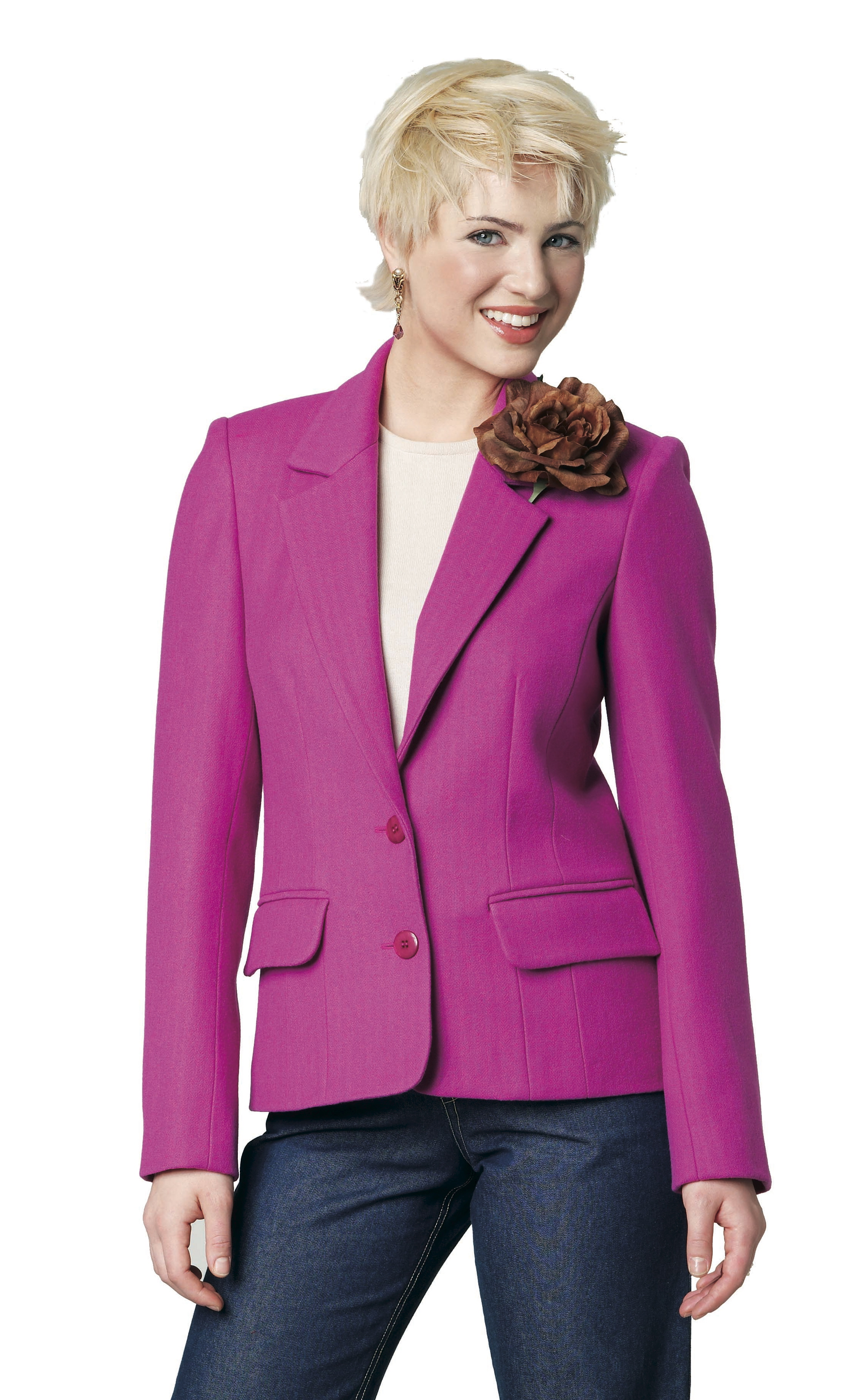
Tailored & Artistic & the Flower says Romantic
Which personality type feels most like you? This is the type that reflects your most dominant personal style. Do any of the other styles also resonate with you? You might be a combination of these styles, as many women are. However, you will find it saves shopping time and money to stick with your dominant style for basic and major wardrobe items. As a result, you will have a more consistent look and a more flexible wardrobe.
Clothes for evening and sports activities are an easy way to break out of your normal image for a change. And accessories are a way to incorporate a secondary style. For example, if your look is mostly tailored, but you have a dramatic or creative side, a bold piece of jewelry pinned to your tailored blazer, or topping your business skirt with a brightly colored jacket, will make the statement you want.
Making it Your Style
Your career or lifestyle might require a certain way of dressing but for you to feel comfortable and confident, your clothing must also give you the feeling of “it’s me”. Two women can put together the same basic wardrobe pieces, but because of their “personal style” they will look different.
Here’s how one basic dress can become Tailored Classic, Sportive, Romantic, Dramatic/Creative (left to right) with different accessories.

One dress, four Personal Styles
If you are still struggling to identify your style, set up a file of magazine clippings of fashion looks that appeal to you or create a “style inspiration” board on Pinterest. You will see a pattern develop of the clothing style that feels most comfortable to you. You’ll also be inspired by the many different ways to bring both dominant and secondary styles together through color and accessories.
Taking time to identify your personal fashion style will free you from being a slave to fashion trends — jumping from one look to another — and help you build your wardrobe in a distinctive manner.
As Coco Chanel said, “Fashion is fleeting…style endures.”
If you would like more guidance plus a personalized approach to identifying your style and building a wardrobe that works for your lifestyle, please contact me for an in-person or virtual consultation. Our first half-hour together is complimentary.
Note: All art and photos courtesy of Palmer/Pletsch Associates, publishers of Clothes Sense, Looking Good and Looking Good…Every Day: Style Solutions for Real Women.
Dressing Your Best: The Rule of Thirds
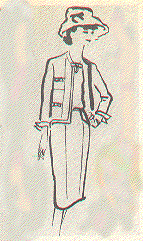 “Fashion is architecture: it is a matter of proportions.”
“Fashion is architecture: it is a matter of proportions.”
— Coco Chanel
How many times have you gotten dressed, looked in the mirror and said “Something looks ‘off’ here”? It might simply be a matter of proportions. Proportion is the framework with which we build our outfits, consciously or not. And the relative proportion of color or design elements can make or break a look.
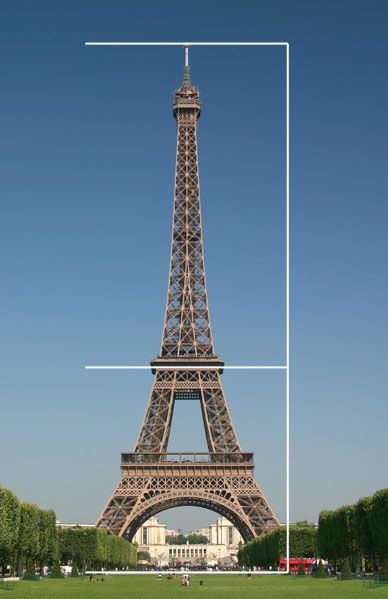
There are many guidelines I use to help to determine what looks best on me and on others when combining separates. One of the most useful is the Golden Ratio – also called the Golden Mean – a ratio that appears in nature that we find aesthetically pleasing. The Golden Ratio has applications in mathematics, architecture and art…and also fashion. The ancient Greeks claimed that a 1/3 to 2/3 ratio is the most aesthetically pleasing division of spaces. In fashion, this is often referred to as “the rule of thirds”.
Look at the Eiffel Tower, considered one of the greatest structures ever erected. It breaks visually into roughly 2/3 at the top, 1/3 at the bottom. Painters and photographers use visual applications of the same ratio to compose their works.
How do you apply this to dressing in a way that is proportionally most pleasing to the eye?
Co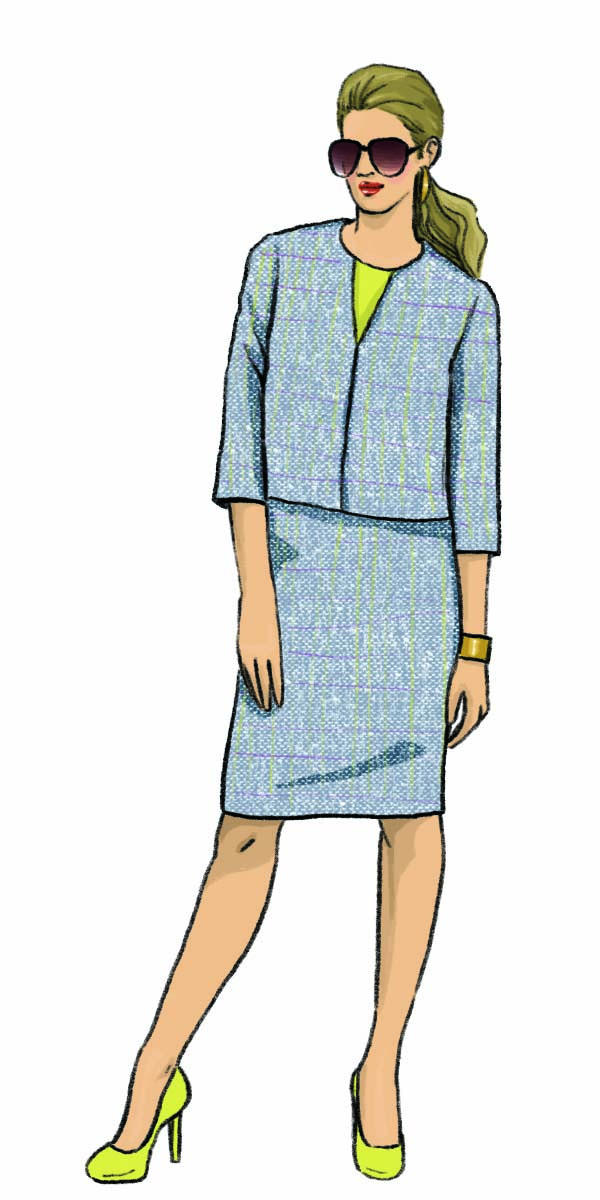
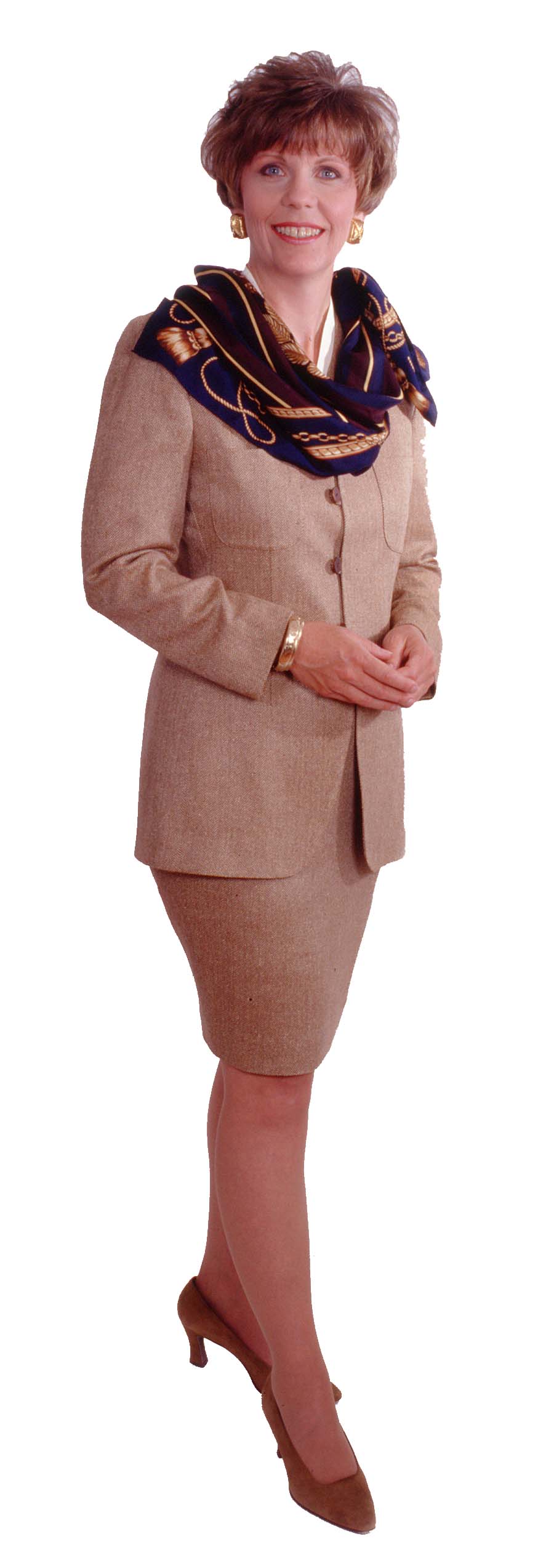 mbining Separates
mbining Separates
A balanced one-to-one ratio can be dull or boring. Unbalanced proportions are much more interesting and pleasing to look at. As you put items together, think in terms of dividing your overall look into thirds rather than halves or quarters:
• Combine items that are uneven in proportion to each other: Instead of two items that are the same length, look for a long and a shorter garment to put together:
– The blue-gray suit in the illustration on the far left is boxy looking because the jacket and skirt are about the same length (1/2 to 1/2 as parts of the whole ensemble). A short jacket looks best with a longer skirt or trousers. The Chanel suit in the illustration at the top of this article is more interesting because the short jacket tops a longer length skirt.
– A longer jacket looks best over a short skirt (see the tan suit above right, which is a 2/3 to 1/3 rela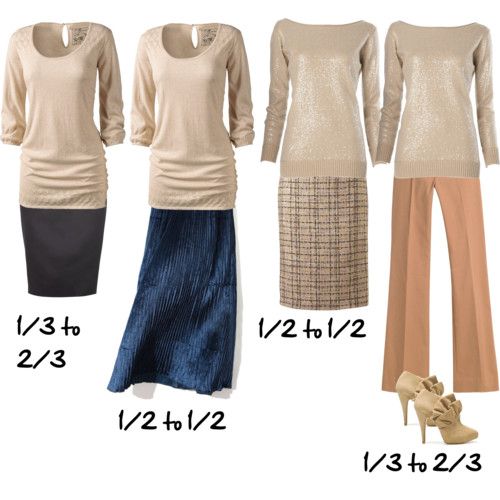 tionship) or even with trousers, not with a skirt that’s mid-calf length (as this would create a 50:50 – 1/2 to 1/2 – relationship).
tionship) or even with trousers, not with a skirt that’s mid-calf length (as this would create a 50:50 – 1/2 to 1/2 – relationship).
– Style expert Imogen Lamport illustrates “the rule of thirds” so well on her blog (illustration at right) that I wanted to share it here: The two outside pictures are in 1/3 to 2/3 ratios; the two middle pictures are splitting the body into halves and neither is as visually appealing as the outside two.
• When evaluating the proportion in an ensemble you’re putting together, consider your entire look, from head to toe. For example, black tights worn with a black skirt are viewed as one element since the tights will appear as an extension of the skirt.
• Always check a full-length mirror to see if the length of your top works with the bottom. Easy adjustments can often be made.
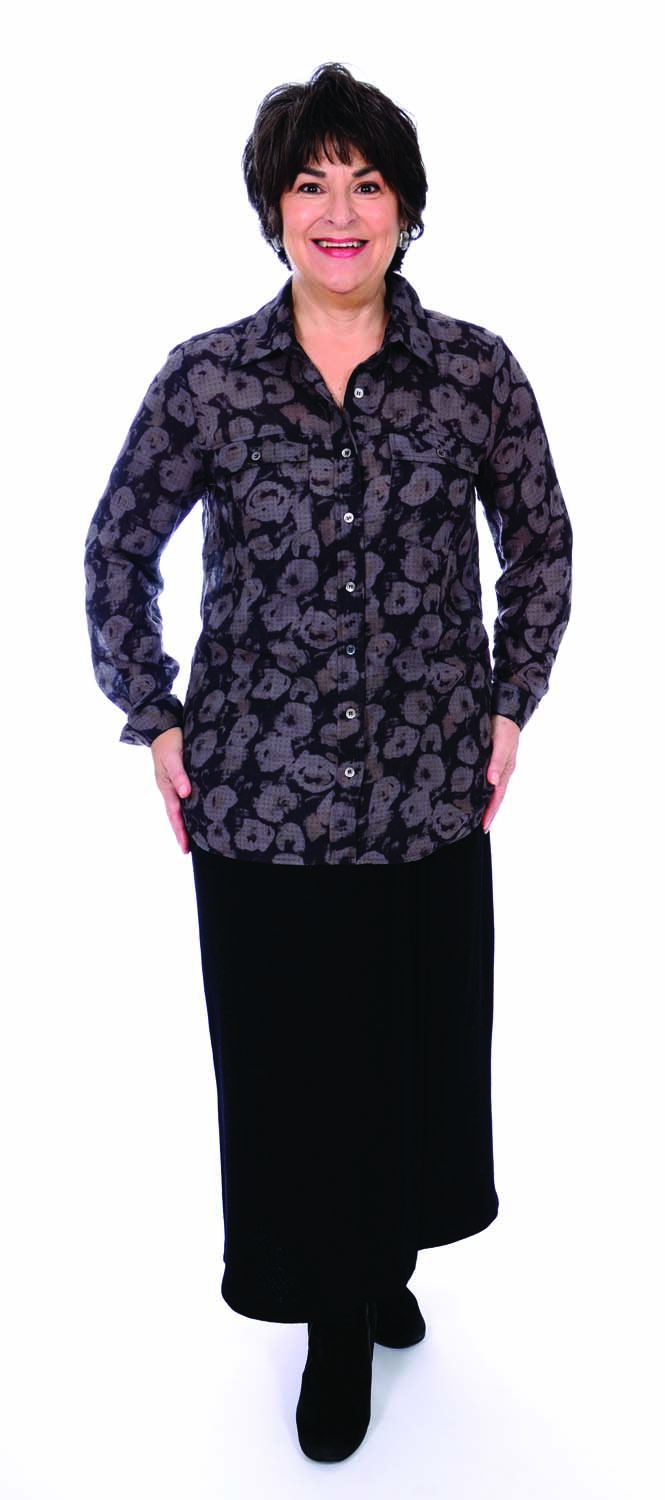
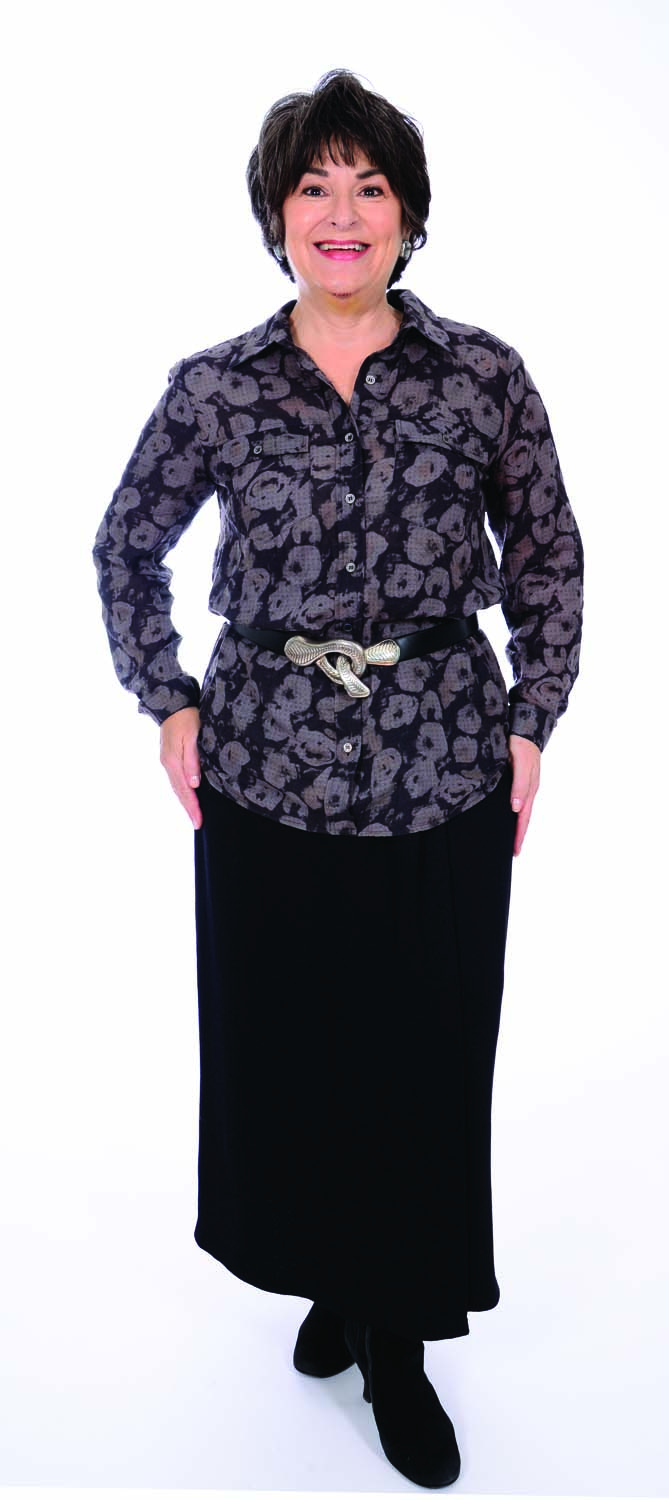 For example:
For example: 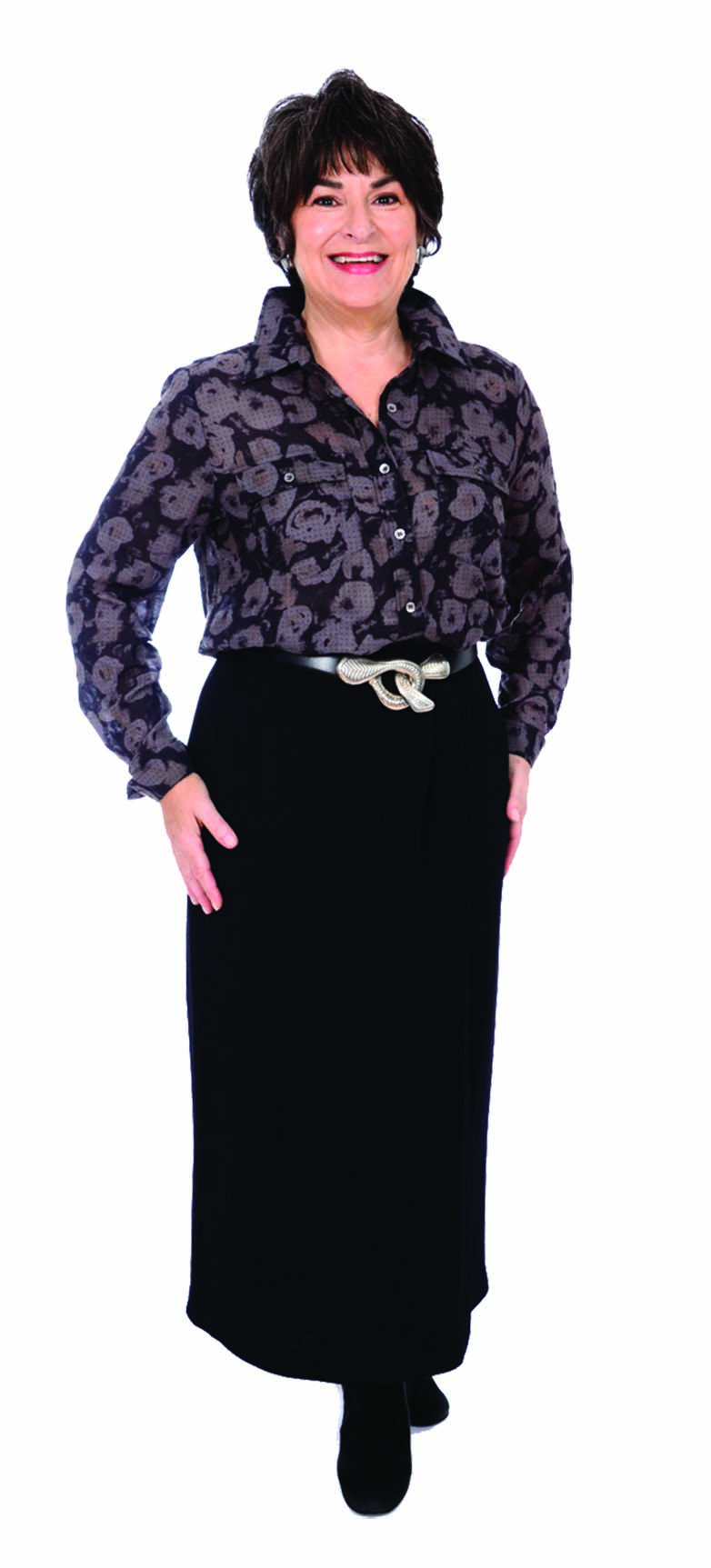 1) On the left, the long top bisects the figure, dividing the space in half, which is not only uninteresting but also hits the model at her fullest body part. 2) In the middle, adding the belt creates a division of space into thirds, which is more interesting. 3) On the right, tucking in the blouse and adding a belt creates the ideal proportion of 1/3 to 2/3…and notice how it also creates a slimmer, taller appearance overall!
1) On the left, the long top bisects the figure, dividing the space in half, which is not only uninteresting but also hits the model at her fullest body part. 2) In the middle, adding the belt creates a division of space into thirds, which is more interesting. 3) On the right, tucking in the blouse and adding a belt creates the ideal proportion of 1/3 to 2/3…and notice how it also creates a slimmer, taller appearance overall!
The rule of thirds is not an absolute but it’s a guideline that, when combined with a knowledge of how to dress for your body type, can help you dress your best. Once you pull on that top or jacket, remember it’s a matter of proportions. Applying the Golden Ratio can make you feel more “aligned”.
Now if you are still fretting in front of the mirror, contact me for an in-person or virtual consultation on how to polish your style and dress your best. Our first half-hour together is complimentary. I look forward to helping you!
( Eiffel Tower Image via The Fashion Code. All model photos from Looking Good…Every Day: Style Solutions for Real Women by Nancy Nix-Rice, Palmer/Pletsch Publications.)
How to Dress for Your Body Type – It’s a Balancing Act!
Do you wish you were thinner or taller? Can’t seem to shrink your middle with dieting? Do you think you have a better face than figure?
Knowing and embracing your body shape and type is the first step to finding clothes that fit and flatter. Using the power of illusion is the second. Few women have a perfectly proportioned body, but clothing and accessories can help create the illusion of one. The principles are not complicated: Emphasize your best features and de-emphasize the not-so-good ones.
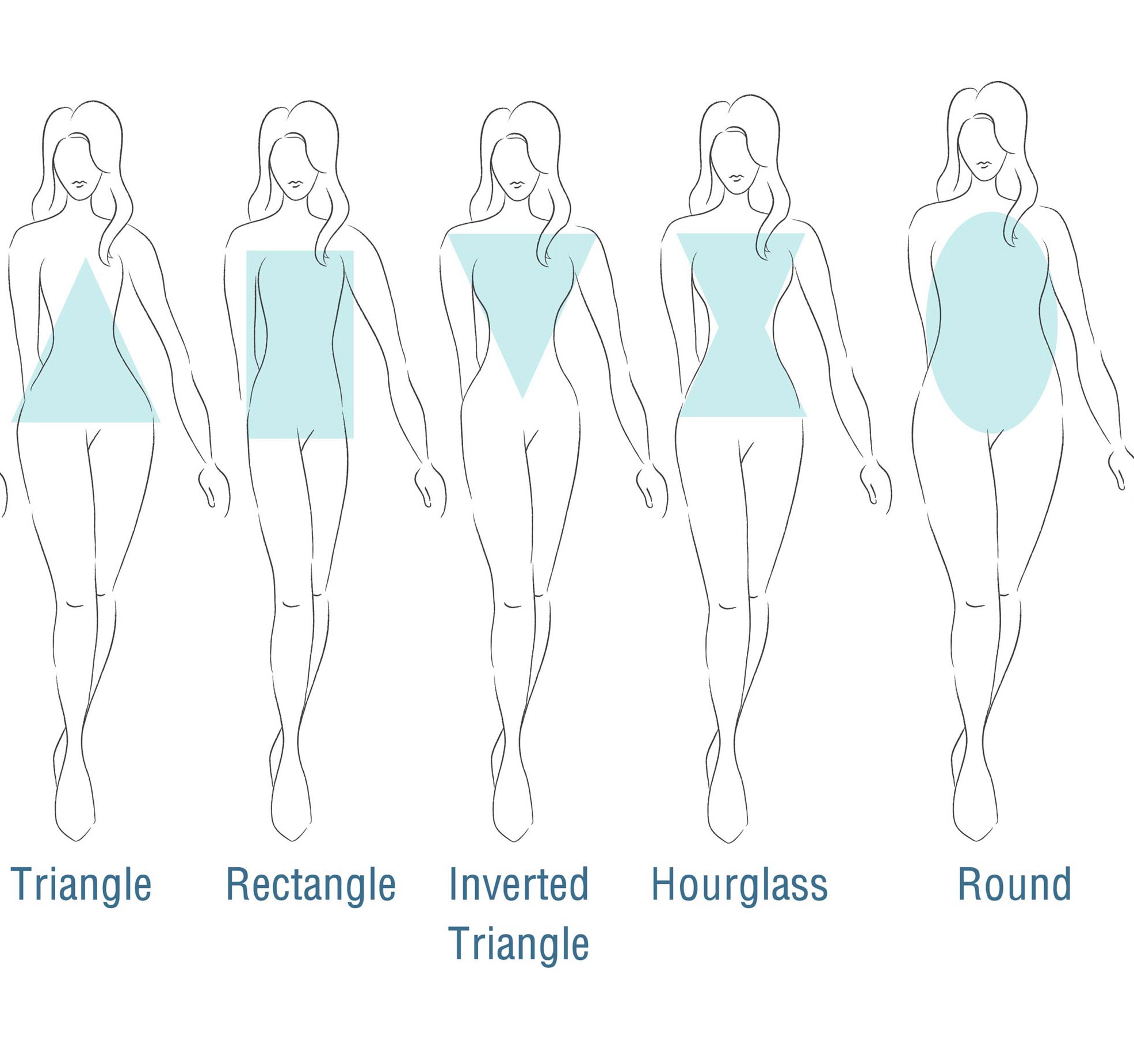
Your Body Type & Your Fashion Goal
Fashion’s ideal female figure is evenly proportioned with hips just slightly narrower than shoulders so garments fall freely over the hips. Most of us, however, are not evenly proportioned so our fashion goals are simple balancing acts. I use the following definitions and guidelines with my clients:
Triangle: Your hips are wider than your shoulders. Goal: Add volume to your shoulders and upper body and minimize your hips.
Rectangle: Your hips and shoulders are balanced but waistline is not well defined. Goal: Create curves and the illusion of a waistline.
Inverted Triangle: Your shoulders are wider than your hips. Goal: Accentuate your lower body and soften your shoulders and upper body.
Hourglass: Your hips and shoulders are balanced and waistline is defined. Goal: You want to show off your curves…but without going overboard.
Round (or Oval): Your waist area is wider than your shoulder or hips. Goal: Elongate your torso and create the illusion of a waist.
The clothing that fits you best has a silhouette similar to your own. Each body type can wear any of the silhouettes but some will be more flattering than others. Keeping your fashion goal in mind, it becomes a balancing act with the illusion of ideal proportions the end goal.
How to Create the Illusion of “Ideal”
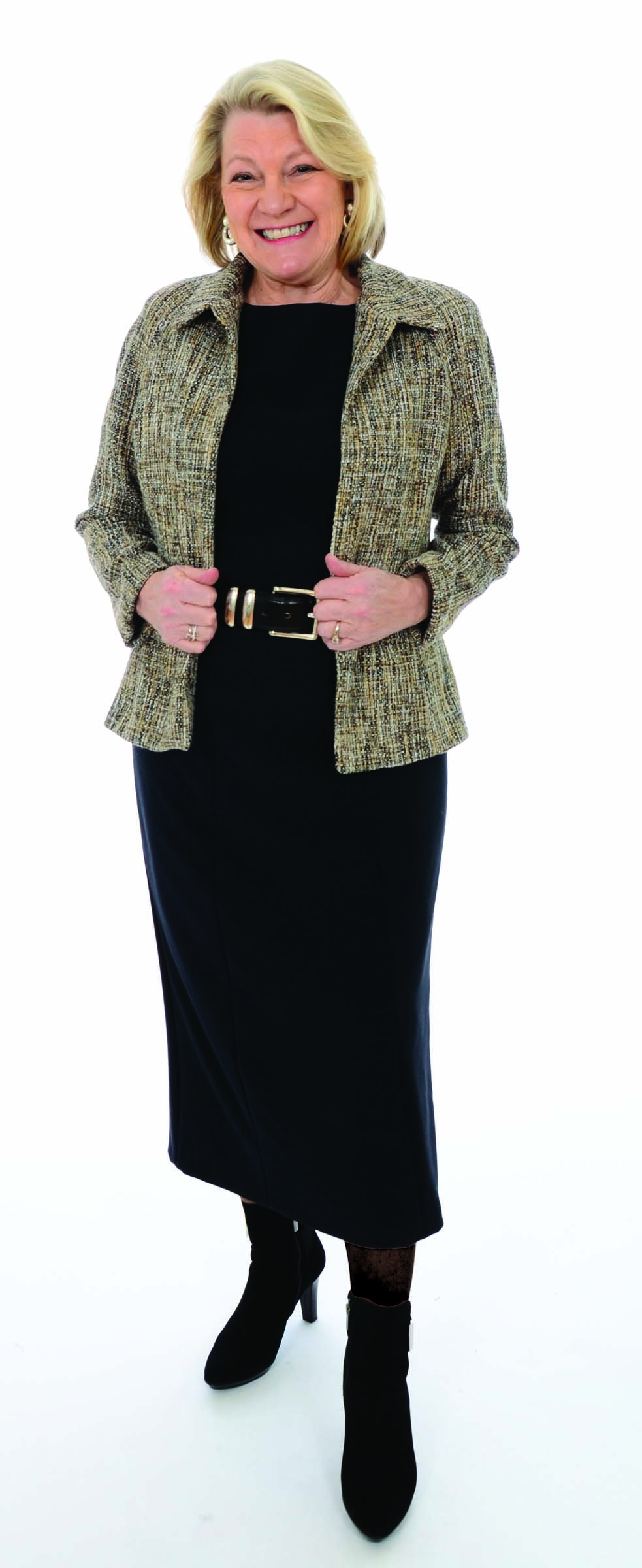
Shoulder shapes; bold, decorative buckle; hosiery toned in with skirt and bootie. (From Looking Good…Everyday)
When evaluating a garment or accessory, look in the mirror and ask yourself: What are my best assets? Does this show them off? Does it take the eye away from those body areas I don’t want to emphasize?
Here are nine easy styling tips to help you choose what to wear to balance your body shape, create desired illusions, and look your best:
1. Shoulder shapes – the best tool for making most women appear better proportioned by strengthening the shoulder to balance every wider area below – hips, thighs, tummy or bust. Even the subtlest lift does wonders! I love removable foam shapes that fit over your natural shoulder and cling to the fabric inside your garment. You can add them to any unstructured jacket, shirt, blouse or sweater. If you can’t find them locally, click here for an online resource.
2. Belts – minor investments that reap major results. A bold decorative buckle draws attention to the center of the body, giving the illusion of a smaller waistline. There’s an even greater effect when the belt is worn under an open jacket. Wider belts can give the illusion of a waistline curve. Another technique is to wear a loose belt, such as a chain belt, off center and at a downward angle.
3. Scarves can be tied in a variety of ways to create focal points. Wear the scarf near your face to draw attention up and away from figure challenges. Drawing attention upward on your body also creates a taller, trimmer appearance. Tie a scarf around your waist to highlight a narrow waistline or give illusion of a waistline curve.
Invest in scarves you love in your most flattering colors. If you follow current scarf tying trends, your scarves will never go out of style. Download the free Hermès Silk Knots app and you’ll learn several ways to tie one on!
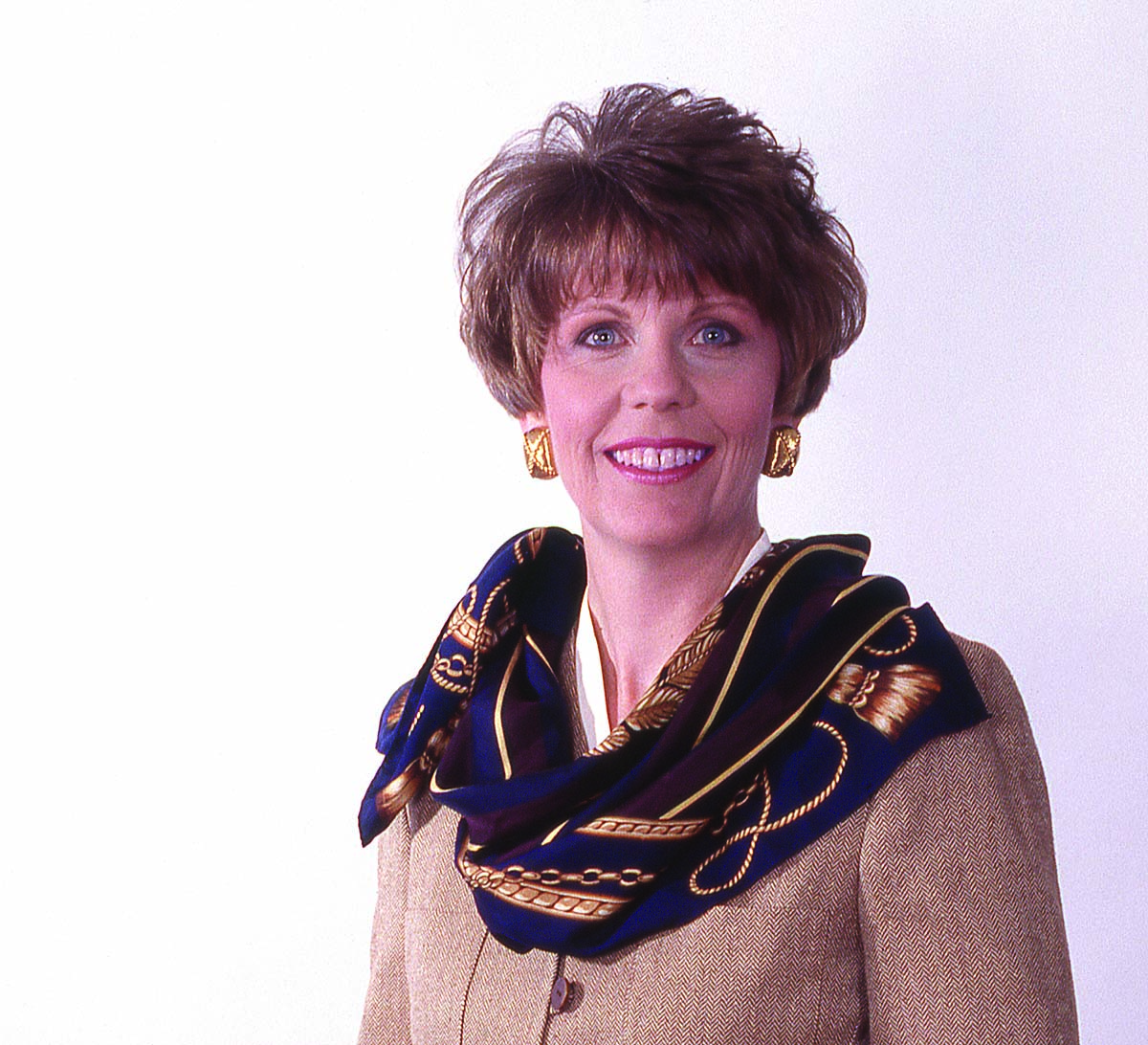
Earrings & scarf draw attention upward. (From Looking Good…Everyday)
4. Jewelry also calls attention to the part of the body where it rests. Use it to balance your proportions and call attention to your assets:
- Bold earrings draw attention to your face; if they relate to your eye color the effect is stronger in keeping the onlooker’s focus.
- A bold pin, placed wide on the shoulder, diverts attention away from your hips.
- A long chain necklace or strand of beads worn with a solid color top brings attention to the center of your body and visually elongates your torso.
5. The clever use of color can go a long way:
- A “column” of the same color worn under an open jacket of a different color is an ideal way to look taller while also camouflaging a fuller waistline (see full-length model above).
- Dark colors distract the eye, while light or bright ones draw attention. Choose your tops and bottoms accordingly.
- Wear medium and darker colors with brighter accents near the face to create a focal point. Find out which colors lighten up your face, bring out the color of your eyes, and flatter your hair – then wear them…all the time!
6. Pants – skinny, straight or boot-cut? – If your top is bigger than your bottom (Inverted Triangle) skinny legs will accentuate the fuller top, creating an unbalanced look. Choose the slight flare in a boot-cut pant to balance the width of your shoulders. Because straight legs or slightly flared pants de-emphasize wide hips, they are the best choice if your bottom is wider than your top (Triangle) (see photo at left).
7. Skirts – short, long, fitted or flared? A longer-than-wide proportion is always more slenderizing. The most flattering hem lengths are at the indentations and narrowing parts of the leg, both above and below the knee.
8. Jacket – short or long, shaped or not? – Short, slightly shaped jackets flatter curved bodies (Hourglass and Triangle) and can create the illusion of a waistline for others (taking a Rectangle to an Hourglass). A longer button-front jacket or blazer creates a long vertical line, visually slenderizing a fuller midsection (Round/Oval). A jacket that hits below the hip offers great coverage but is most flattering on taller and straighter bodies (Rectangle).
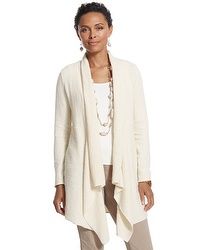
Adding shoulder shapes to this draped cardigan from Chico’s will balance the hips.
The “draped” style: Many women who are fuller through the middle or bottom make the mistake of wearing draped tops and cardigans, some of which have long side “tails.” Draping yourself in loose fabrics won’t hide you. Just the opposite – they make you appear even larger. A draped cardigan looks best when the hip and shoulders are balanced, either naturally or with the insertion of shoulder shapes.
9. Hosiery – You look instantly taller and trimmer when you match the color tone of your hosiery to your shoe and hem (see full-length model above). It’s only the really long-legged woman who can carry off dark hose and shoes worn with a light colored skirt or dress and still look well proportioned.
Use these guidelines for shopping, either in a store or in your closet, and you’ll be on your way to looking your best! For an in-depth look on dressing for your body type, I recommend Looking Good…Everyday: Style Solutions for Real Women by Nancy Nix-Rice (Palmer/Pletsch).
Knowledge is power, but if you would like a professional eye and objective approach to shopping your closet and styling your most flattering looks, don’t hesitate to contact me! Virtual consultations can be scheduled.
It’s Time to Take Control of Your Closet!
You can’t fit another hanger onto the rack without forcing it in?
The closet rod is bending, or worse yet, it’s pulling away from the wall?
You have a closet full of clothes but nothing to wear?
I think I just heard your New Year’s resolution loud and clear: “I’m going to clean out my closet!”
Congratulations! A well-edited and organized closet not only alleviates stress, but it can also minimize future expense. It’s a critical step to streamlining your routine and having a wardrobe that works for you not against you.
Most women wear only 20% of their clothes 80% of the time. Closet clutter causes confusion and a closet overflowing with clothes you don’t wear slows you down. Cleaning out and organizing your closet doesn’t have to be painful. Why not set aside some time now, at the beginning of the year, to gain control of your closet?
GET READY!
Schedule two-hour blocks of time over a week, or one long morning or afternoon. Set the mood with music and pour a cup of coffee…or a glass of wine, depending upon the time of day! Style your hair and put on your makeup and good underwear. Yes, you’ll be trying on most of your clothes and nothing will look good if you don’t.
GET SET!
Gather these important tools:
1. Full-length mirror – if not already installed, it’s an investment you must make, even if it’s the simple over-the-door variety.
2. Sticky notes to label items needing repair or alteration.
3. Large trash bags labeled: “Consign”, “Donate”, “Toss”.
4. Quality hangers to replace any wire ones you’re currently using (see tips below).
GO!
1. Pull everything out of your closet and drawers. (If you live in an area with a change of seasons, focus on clothing for the current season and repeat this process at the beginning of the next season.) Your goal is to divide and conquer: What to “Keep” vs. what to “Cast Off”.
2. Group like items together. If you have six pairs of black pants you’ll want to evaluate them against one another. I like to start with bottoms, then tops, dresses and shoes.
3. Don’t forget your underwear, socks and hosiery, and accessories (scarves, jewelry and bags). These may not all be in your closet but they deserve the same edit-and-organize process if you want to streamline your dressing routine.
4. Try on everything. You can’t tell how something looks by just holding it up to yourself. You have to see the item on you. Let’s face it, our bodies can change one year to the next. And washing and dry cleaning can shrink clothing over time. Be sure to try on the right shoes and undergarments with each item.
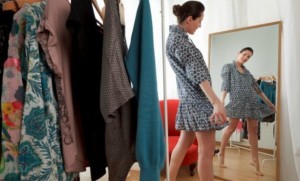 TO KEEP OR CAST OFF?
TO KEEP OR CAST OFF?
Clothes you love and wear frequently are an automatic “KEEP”. For everything else, be honest with yourself. An item does not belong in your closet if:
1. It is ripped, stained, or simply worn out.
2. It doesn’t fit. What’s the likelihood of it fitting in the future? Can it be altered to fit?
Note: If you plan to lose weight, you will want to go shopping to reward yourself!
3. It’s outdated.
Note: Fashions can come and go and come back again; but it seems that they never come back exactly the same. Depending upon cost, restyling a garment might be a possibility. But, how much will it cost and would you pay that much to buy the item new? Would replacing the item be less expensive?
4. The color does not flatter your skin tone (see my earlier posts on Color).
Note: Have you had your colors done? If so, you can speed up this process by first sorting out the colors that are not in your palette. That’s why you had your colors done!
5. You aren’t wearing it (you loved the color, or it was a great bargain, but it really wasn’t “You”) and/or you haven’t worn it in two years, because chances are you won’t.
6. You’re keeping it just because it has sentimental value. (Okay, if it has a good backstory and looking at it brightens your day, keep it…but don’t let it take up precious space in your working closet. Store it elsewhere and promise me you’ll evaluate it again in six months.)
Finally, if closet space is tight and you have multiple very similar items, such as those six pairs of black pants, consider whether you need them all. Pare down to those that fit best, are the most current, and in top condition.
If any “Keepers” need cleaning or minor repairs, label them with a sticky note and take care of it ASAP.
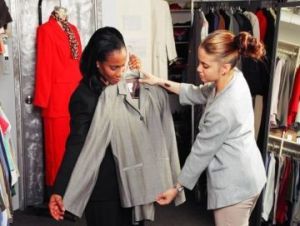
Dress for Success
How to Handle the “Castoffs” – They may be losers in your closet but winners for someone else:
- Friends or relatives – it may no longer be “you” but someone else might love it.
- Consignment shops generally pay 50% of the resale price. Clothes need to be cleaned, pressed, repaired, and seasonally correct.
- Dress for Success: The clothing they provide women is primarily for job interviews. Most chapters can only accept items in clean and good condition, current style and all-season weight, and on hangers.
- Goodwill or other charitable organizations are the best place for gently worn, out-of-season clothing, and your contribution will be tax deductible.
- What about worn-out or torn items? Before trashing them, please check online for a recycler in your area who accepts and reuses textiles.
PUTTING THE “KEEPERS” BACK INTO YOUR CLOSET
Your goal is to be able to see everything every time you open the closet door so it’s much easier and faster to get dressed in the morning.
1. Hang everything you ca n. Don’t put anything in drawers that you can hang or stack on open shelves (out of sight, out of mind!).
n. Don’t put anything in drawers that you can hang or stack on open shelves (out of sight, out of mind!).
2. Double your hanging space by creating two hanging levels so that you can hang each garment separately and see tops in relation to bottoms. You’ll be amazed at how many new combinations suddenly appear. Separate the suit pants and skirts from their jackets so the pieces can be worn separately.
Note: You don’t have to remodel! The Container Store offers an affordable double hang closet rod solution.
3. Keep like items together by categorizing your clothing by function – for me it’s active wear/daywear/evening wear – then by type: jackets, skirts, pants, dresses, etc.
4. Organize by color – light to dark, starting with neutrals followed by colors of the rainbow: red, orange, yellow, green, blue and purple. This creates an aesthetic that is pleasing to the eye when you open the door to your closet!
5. Pants – If using double hanging space, hang them uniformly folded over non-slip pant hangers. If you need to hang them in a long-hanging space, use clip-style hangers and hang them from the waist.
6. Skirts – You can maximize closet space by using cascading clip hangers.
7. Jackets, shirts and blouses – Use hangers that support the shoulder and the weight of the garment. For blouses and shirts I use color-matching plastic tubular hangers. For jackets I prefer a hanger with more shoulder shape to provide shoulder support.
Note: Many wardrobe consultants favor the space-saving hangers with the velvety non-slip finish for all needs. This will give you a nice coordinated look!
8. Sweaters are best folded, either stacked on a shelf or individually folded over a hanger. Vertical shelf dividers that clip onto the shelf will keep the stacks tidy. See-through plastic boxes are perfect for dust-free shelf storage for sweaters and ideal for shoes. Label them for speedier access.
9. Store accessories so they are visible and accessible. Use the inside of the doors for extra hanging space. Add towel bars for folded sweaters or scarves, a shoe rack, and/or cup hooks for jewelry or belts.
For more wardrobe organization solutions, as well as great clothing care tips for getting longer life out of your clothes, I highly recommend Looking Good …Every Day: Style Solutions for Real Women by Nancy Nix-Rice (Palmer/Pletsch Publications)
CLOSET RULES MOVING FORWARD
A closet cleanout should be a seasonal habit, ideally early each season – August for the fall/winter and March for spring/summer – because stores have the best selection of things at that time to fill in gaps. Resolve to follow these tips and rules to maintain a well-edited closet year-round:
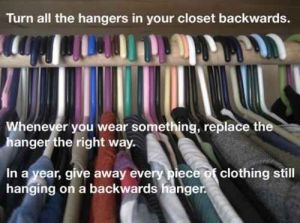 1. Turn the hangers around. Turn all of the hangers holding clothes in your closet backwards. When you wear something, return it to its place with the hanger turned correctly. At the end of the season, you‘ll have an accurate record of what you wore and what you didn’t. Consider this: In a year, give away every piece of clothing still hanging on a backwards hanger!
1. Turn the hangers around. Turn all of the hangers holding clothes in your closet backwards. When you wear something, return it to its place with the hanger turned correctly. At the end of the season, you‘ll have an accurate record of what you wore and what you didn’t. Consider this: In a year, give away every piece of clothing still hanging on a backwards hanger!
2. One in, one out. Maintain the flow of items out of your wardrobe as often as you put new items in. Consign or donate used or unwanted pieces whenever possible
3. Don’t overcrowd. Stow seasonal items in a separate closet or storage space.
4. Remove all plastic dry cleaning bags from every item in your closet. They trap dry cleaning chemicals and can cause staining.
5. Banish wire hangers! Remove dry-cleaned items from wire hangers as soon as you get them home and hang them on proper hangers.
Congratulations! You’ve streamlined your wardrobe and dressing everyday should be quicker and stress-free.
Note: All photos from Pinterest unless otherwise noted.
If the thought of doing a closet edit alone is overwhelming, or you find it difficult to perform an honest assessment of your wardrobe, then it’s time to get some help. Contact me – I’m here to guide and advise you!
Ten Tips for a “Carry-on” Vacation Wardrobe
![]()
I’m leaving on a two-week trip to Northern Italy tomorrow that will take me from the city of Milan to the coastal and casual Cinque Terre, and then up to Lake Como. While planning my wardrobe, I’ve focused on traveling light while meeting the changing weather conditions that autumn brings. And I’ll be packing it all into one 22-inch carry-on bag that will make both plane and train travel easier.
“Pack light” is my mantra and should be yours, too. Here are ten guidelines – plus a peek into what I’m packing – to help you plan your vacation wardrobe and scale down to one carry-on bag:
1. Limit your color palette. Plan everything around a basic neutral color. Choose medium to dark solid colors for your main wardrobe pieces (my personal favorites are black and charcoal grey – they coordinate easily and don’t scream “I’m a tourist!”). Add color with scarves.
![]()
2. Choose versatile pieces that can mix and match and let go of the idea of wearing a different outfit each day. Plan to wear each item more than once. For example, a blazer worn on the plane can also be worn casually with jeans or dressed up for dinner. This is the “capsule wardrobe” concept and you’ll find many examples on Pinterest. My own wardrobe is quite 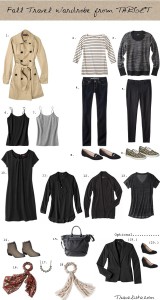 similar to this one from Target.
similar to this one from Target.
Note: Pack clothes that you love, so you feel good wearing the same things many times in different combinations. I’m taking a favorite grey wool doubleknit cardigan jacket, plus two lightweight cardigan sweaters, one beige (cotton), one black (merino wool). Both are ¾ length and can be layered over everything for day or evening.
3. Take more tops than bottoms. Every top should go with every bottom. Several tops will maximize the wear of your bottoms; and they weigh less, take less room, and are easier to launder.
Tops, bottoms…How many pieces do you need? Two or three pairs of pants, plus one jacket, plus four to six tops can meet your needs for one week. For two or more weeks, I take one more bottom (pant or skirt) and more tops and launder/clean any items that need it before repeating. For this trip, I’m packing two pairs of pants for day wear and a third pair for evening – you might choose to pack a skirt or dress instead of another pant.
Note: I’m also packing hand-washable, drip-dry tops that require no ironing (Heattech T-shirts from Uniqlo and non-iron white shirts from Brooks Brothers are two favorites). Underwear made of comfortable wicking fibers can be washed in your hotel room and will dry overnight. Planning to do hand laundry, I’m only packing three sets of undies and bras (one to wear, one to wash, and one spare).
4. Choose thin items over bulky ones, lightweight fabrics versus heavy. Two thin sweaters (turtleneck + cardigan) are as warm as one bulky sweater but are more versatile and take less space. For the changing fall weather, and going from the city to the coast and back north again, I’m packing items that can be layered (Heattech T-shirt + cardigan sweater + jacket + trench coat when I need the most warmth).
5. Plan to double up. Pack versatile items that can do double duty, such as a blouse thatcan also be worn as a jacket over a camisole, a long t-shirt that can serve as a beach cover-up. (The red lightweight wool shawl I carry on the plane to use as a blanket will be worn over a black top and pants for evening.)
6. Accessorize with lightweight jewelry, belts, and scarves and you’ll achieve several different looks. Unless you’re on a group tour, it’s unlikely you’ll see the same people every day. If you do, they will admire your wardrobe creativity!
7. Exercise shoe control. Take no more than three pair of shoes. Shoes are bulky and heavy. Travel in one pair and pack the others. I’m packing a lace-up sneaker style shoe by ara for daytime city walking (many “on-the-street” photos from Milan’s recent Fashion Week show bright sneakers as a current fashion staple!), a supportive walking shoe by Naot for the hills of the Cinque Terre, and a dressy flat by Clarks for evenings. All are very comfy and have been broken in before this trip (cute shoes that kill you are a waste of space).
8. Ignore the urge to add in “but what if…” Plan what to pack based on the weather and your activities, packing for what is known as well as logical possibilities. Logical: rain, so I’m taking my new trench coat and umbrella (plus a packable hooded water repellant jacket for the Cinque Terre). Not logical: an impromptu formal evening. If that actually happens, I’ll be in Milan and will have the perfect excuse to shop my heart out!
9. Minimize cosmetics and toiletries by taking only the amount needed for the trip. One ounce of shampoo lasts for two weeks with daily use. Buy sample size cosmetics or transfer the amount needed to a small container. Note: If you are flying with a carry-on bag, be sure to follow TSA’s 3-1-1 rule.
10. Make use of every inch of real estate in the bag. Fill shoes with rolled up socks, belts, jewelry in a soft pouch, or underwear. Roll casual knit clothes and tuck them into the “valleys” created inside the bag by the handle assembly. For tips on how to pack your suitcase be sure to watch my video series. For more comprehensive packing information and how-to’s on customizing your travel wardrobe, order a copy of Smart Packing for Today’s Traveler by Susan Foster.
Travel Day tips:

Galleria Vittorio Emanuele – Milano, Italy
* Travel with a tote that, in addition to your reading materials, electronics, medications, etc. can hold the handbag (preferably a cross-body style) you’ll be using during the day, and inside of that, a wristlit bag (more sensible than a clutch style) for evening. If you are carrying your luggage onto the plane, this will keep you to the rule of only one carry-on bag plus a handbag.
* Travel in your heaviest clothes, both to and from your destination, and carry your raincoat.
I invite you to share my travel experience and a few “on-the-street” fashion shots from Milan, Genoa, and Lake Como, by following me on Facebook.
And, if you need more help in planning your next vacation wardrobe, don’t hesitate to contact me. I offer a free 30-minute phone consultation and am skilled at working with my clients virtually!
Arrivederci!
How to Build Your Wardrobe With Your Best Colors – Part 2
The Strategic Use of Color
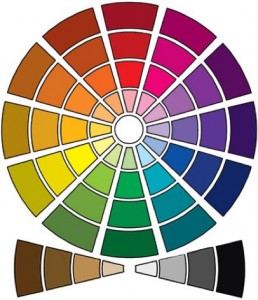
Building a wardrobe based on your most flattering colors is both an art and a science. This rings true not only in identifying your most flattering colors, as discussed in my previous post, but also in how you work with your color palette. Here’s an overview of your color groups and how I guide my clients to use color strategically as they build their wardrobes:
Neutrals – Wardrobe Workhorses
Your best neutrals are those with the same undertone (cool or warm) as your own coloring. The true neutrals are black, white, and grey but certain colors can be neutrals too: beige, brown, burgundy, navy, forest green, teal, plum. Do you see lots of neutrals in your closet? That’s good news as they are your best choice for wardrobe basics. Neutrals give you the most wardrobe mileage because they can be worn again and again without being remembered. They act as backdrops for your personal coloring and best fashion colors.
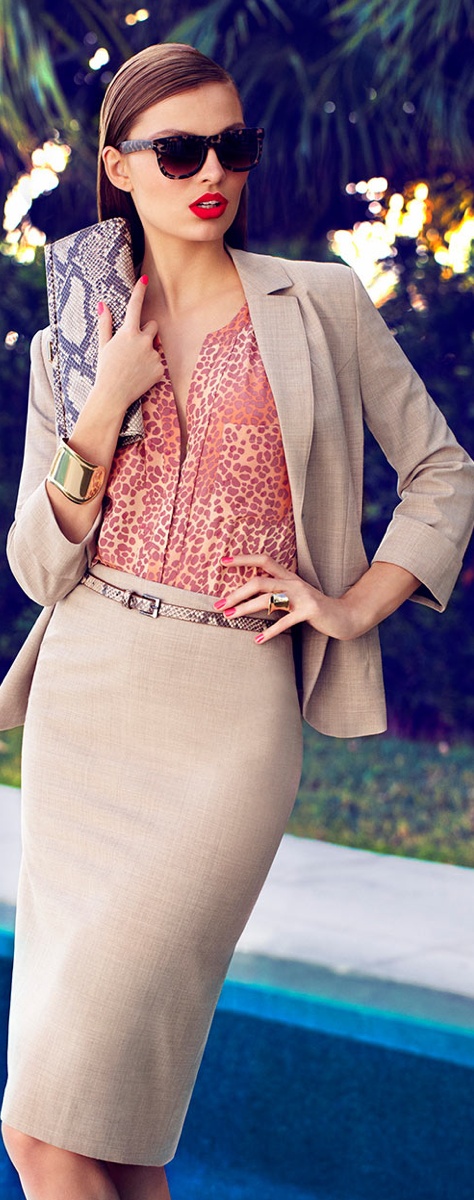 Your most flattering neutrals are those that repeat part of your personal coloring – hair, skin or eyes. The most important neutral is your natural hair color. (I often advise women to make major wardrobe purchases, such as a coat, in their hair color.)
Your most flattering neutrals are those that repeat part of your personal coloring – hair, skin or eyes. The most important neutral is your natural hair color. (I often advise women to make major wardrobe purchases, such as a coat, in their hair color.)
Wearing Neutrals:
Dressing head-to-toe in neutrals can be a sophisticated, elegant look but only if you avoid monotony by incorporating two of the following: contrasts in light and dark values, texture, print or shine, or unusual design lines. A neutral colored suit, pant and skirt can play multiple roles in your wardrobe when you start combining them with a scarf, blouse, or jacket in one of the fashion colors your color analyst gave you.
Black & White
Your closet may be as full of black as mine is (it’s my favorite for travel). Yet, black is not as flattering on many women as other neutrals. Why? It’s not a part of most women’s personal coloring. If this is true for you but you’re not ready to eliminate black from your wardrobe, top those pants and skirts with your best fashion colors.
What about that black suit or jacket? Here’s a tip Nancy Nix-Rice gives in her new Looking Good…Every Day book: Wear a black jacket with a neutral top similar to your hair color then add an accessory that has both black and your hair color to pull it all together.
About White: Bright white can be too harsh and overpowering for someone with warm or soft coloring. The wrong white can also make your pearly teeth look yellowed. Pearl, cream, and softly greyed whites are more flattering for many women (my wedding dress was a champagne color!). Other tips:
* White demands attention. Use it to spotlight an area you’d like people to notice or to distract the eye from a color that is not so good for you.
* It’s best not to wear white in large quantities unless you have lots of contrast in your coloring, like dark hair and pale skin.
Eye Color
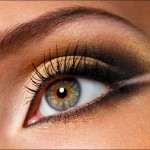 Most people have at least three colors in their eyes and some as many as 20. The composite color, seen best from three feet away, is one of your most effective wardrobe colors. Your eye color expresses calmness, compassion, and trustworthiness. Worn near your face, it causes people to focus on your eyes – a plus in any one-on-one communication.
Most people have at least three colors in their eyes and some as many as 20. The composite color, seen best from three feet away, is one of your most effective wardrobe colors. Your eye color expresses calmness, compassion, and trustworthiness. Worn near your face, it causes people to focus on your eyes – a plus in any one-on-one communication.
Red
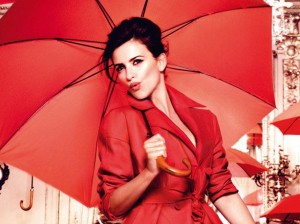 Everyone can wear red – it enhances either the femininity or masculinity of the wearer. If your skin tone is warm, wear yellow-based orangey reds. If your skin tone is cool, wear blue-based cherry reds.
Everyone can wear red – it enhances either the femininity or masculinity of the wearer. If your skin tone is warm, wear yellow-based orangey reds. If your skin tone is cool, wear blue-based cherry reds.
Red is considered the most romantic color and it intensifies other people’s reactions to you. Once considered purely a color to wear on social occasions, red is a staple today in many women’s career wardrobes. Don’t be afraid to wear it, just choose the occasions when you know you can handle anything!
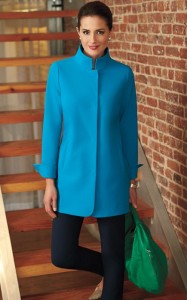
Nina McLemore, Fall 2014
Dramatic Colors
Complementary colors (those opposite each other on the color wheel – see below) enliven each other, creating excitement, drama. For most people, blues and blue-greens are their dramatic colors because they enhance the orange and red-orange in the skin. Dramatics can be worn alone, or used to add a spark of color to neutral outfits. Attention to detail in grooming is a must when you choose dramatic colors since they draw all eyes towards you. Don’t wear them when you’d rather not be seen or heard.
Elegant, Understated Colors
This last group of colors has been defined differently by various color consultants. Some identify “understated” colors as your deep neutral colors (separate from those that are “reserved” or “conservative”). Others say that if you take away your dramatic colors, your reds, your eye colors, and your neutrals, your remaining colors are your elegant, understated colors. If you are ever in doubt about what color is appropriate for an occasion, select one from this category. You will always look attractive in these colors, but the key thing to remember is you won’t stand out like you do in dramatic colors and reds.
Psychology of Color
The colors you wear can contribute to your success in any negotiation or meeting, whether it’s a first date or a major business deal. Although people will react differently depending on personal preferences, studies have shown that most people make certain color associations, such as:
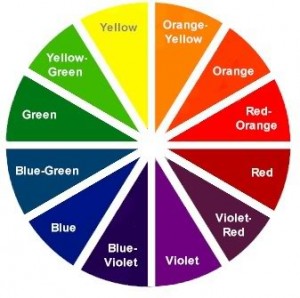
Navy Honest, Trustworthy, Organized
Black Sophisticated, Authoritative, Strong
White Fresh, Precise, Artistic
Crème/Camel Elegant, Approachable, Trusting
Brown Stable, Secure, Persevering
Grey Conventional, Refined, Authoritative
Burgundy Classic, Refined, Elegant, Formal
Teal Inventive, Soothing, Balancing
Yellow Cheerful, Stimulating
Green Refreshing, Natural, Calming
Remember These Facts About Color…
- Color is the first thing your eye sees.
- Color can influence your emotions and those of the people around you.
- Colors build confidence when you know they are personally enhancing.
Color is the most important component of your look. You can use it to expand your wardrobe, reflect your personal style, and send a message to people around you!
Unless otherwise noted, photos are from Pinterest.

